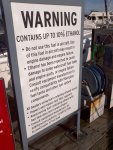Re: Does your fuel island have this warm fuzzy?
I agree with everything but that. The energy density is quite a bit lower.
Gasoline is 116,090 BTU/Gal and Ethanol 76,330 BTU/Gal (Low Heat Value)
http://www.afdc.energy.gov/afdc/pdfs/fueltable.pdf
So if 85% of your gal is Ethanol then 76,330 x .85 = 64,881
And 15% of your gal is Gasoline then 116,090 x .15 = 17,414
Then your gasoline of E85 only contains 64,881 + 17, 414 or 82,295 BTU/Gal or only 71% of the energy content of gasoline.
Sooooo . . . it can't get the same Mileage if it's
in the same engine.
I agree with your post except....

The, "Mileage was essentially identical" statement is vague and doesn't specify what "Essentially" means. 1%? 10%??
Two factors may help level the playing field.
1. Advancing the timing and increasing the intake manifold pressure technically means that it is NOT
in the Same Engine.
By advancing the timing and increasing the intake manifold pressure, the effeciency of the conversion from heat to horsepower will be increase by a small but unknown, meaningfull amount.
2. The mixture of alcohol with gasoline does not produce a linear increase in volume.
In other words, mixing 85 ounces of alcohol with 15 ounces of gasoline does NOT yield 100 ounces of E-85.
The final mixture will yield a solution of higher specific gravity and of less volume than the two liquids that you started with.
An analogy would be like adding a cup of sand to a pail of gravel.
The pail would be no more full, but will be heavier, as the sand filled in the spaces between the gravel.
So 100 ounces of E-85 actually contains more than 85 ounces of alcohol and 15 ounces of Gasoline.
I am not saying that this will cancel out the loss of heat of combustion of the mixture, but it will reduce the apparent loss to some extent.























